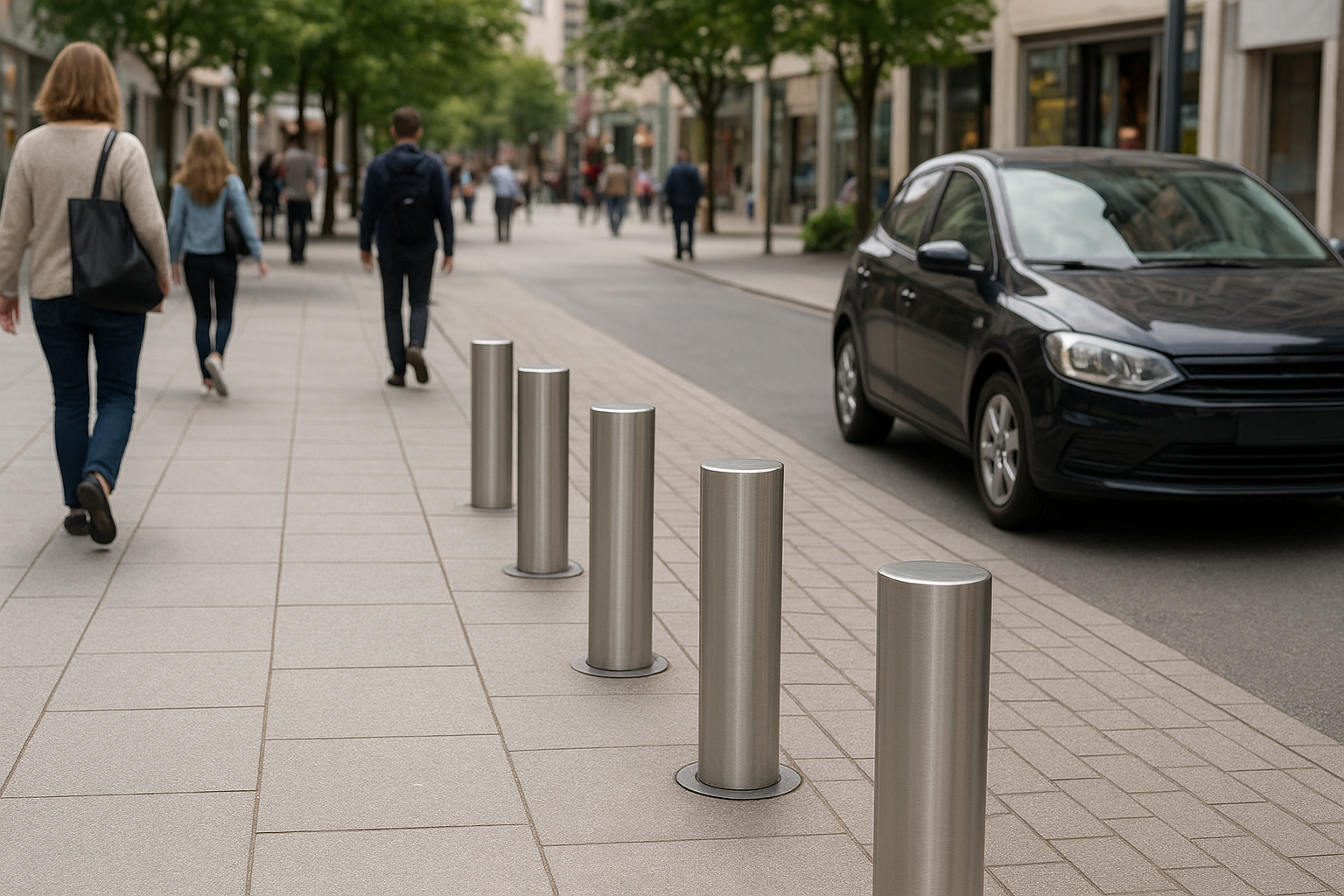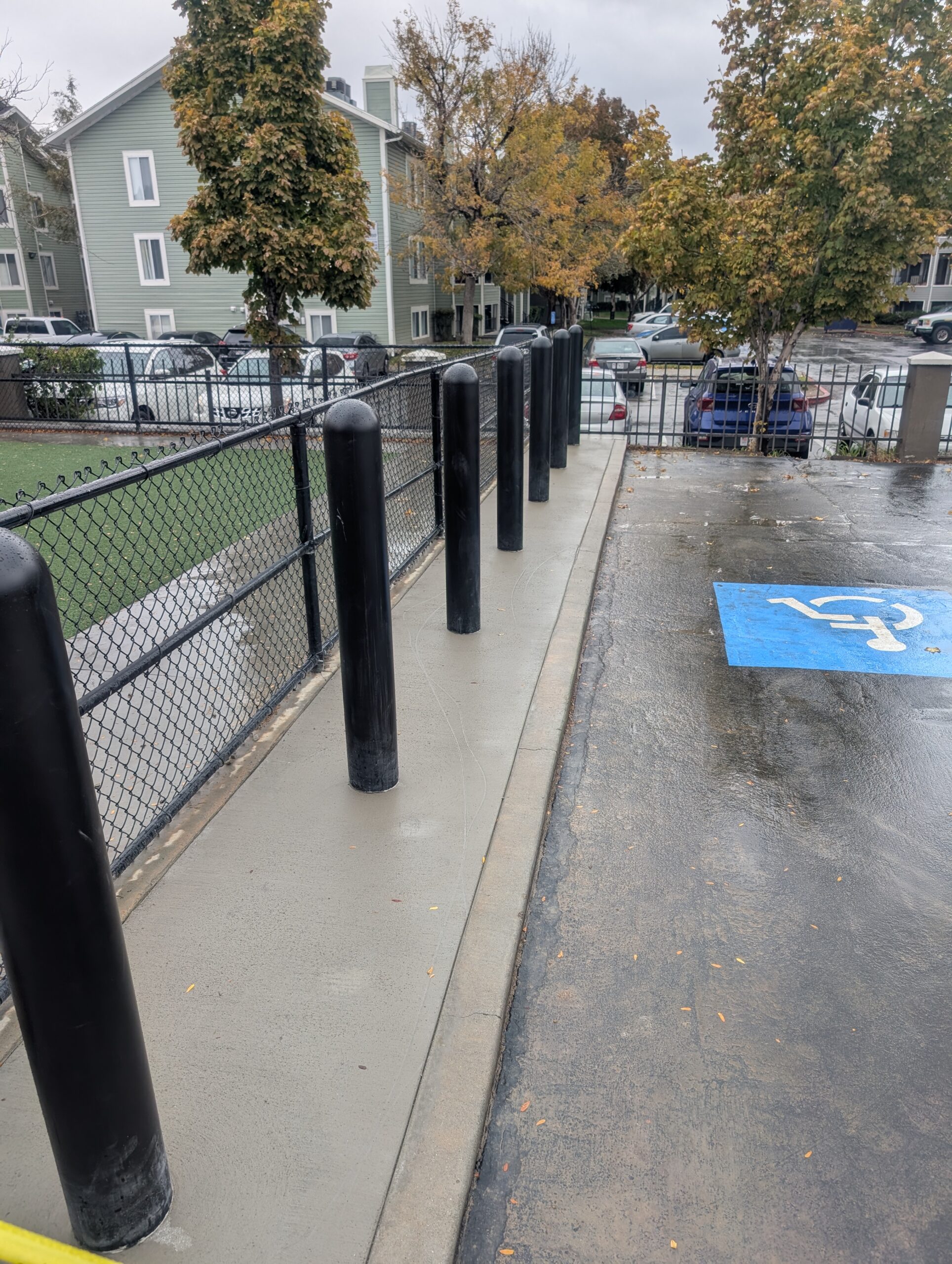Whether stopping a runaway truck, guiding pedestrians, or enhancing urban aesthetics, their mechanics make them indispensable.
How Bollards Work: A Technical Overview of Their Life-Saving Mechanics
Introduction
Bollards, the unassuming vertical posts dotting urban landscapes, are critical infrastructure components that protect lives, manage traffic, and enhance aesthetics. As cities face rising vehicle-related threats and pedestrian safety concerns, understanding how bollards function is essential for planners, businesses, and communities considering their installation. This bulletin from Bollard Brothers provides an in-depth look at the mechanics behind bollards, detailing their types, materials, and operational principles, backed by real-world data and applications as of August 2025.
The Core Mechanics of Bollards
At their essence, bollards work by leveraging physical strength, strategic design, and, in advanced models, mechanical or electronic systems to control vehicle movement and protect spaces. Their functionality depends on type, purpose, and environment, but all bollards operate on principles of impact resistance, structural stability, and adaptability.
Fixed Bollards: The Immovable Guardians
Fixed bollards are permanent barriers embedded in the ground, designed to stop vehicles and protect pedestrians or infrastructure. Their mechanics rely on:
Anchoring: Root-fixed bollards are installed in pits 2-3 feet deep, filled with high-strength concrete to create a rigid base. The concrete distributes impact forces, preventing uprooting.
Material Strength: Typically made from stainless steel (316-grade for corrosion resistance), reinforced concrete, or cast iron, they absorb kinetic energy from collisions. For example, a steel bollard with a 6-inch diameter can withstand impacts from a 7,500-pound vehicle at 30 mph, per ASTM F2656 standards.
Energy Dissipation: Upon impact, the bollard deforms slightly, converting kinetic energy into heat or structural bending, protecting nearby people or buildings.
Real-World Impact: In 2024, fixed bollards in Chicago’s Loop district reduced pedestrian-vehicle collisions by 20%, saving an estimated 150 injuries annually, according to city traffic data.
Applications: Ideal for permanent pedestrian zones, storefronts, or historic sites where aesthetics matter, such as Bollard Brothers’ decorative cast-iron bollards in Riverton’s town square.
Removable Bollards: Flexible Protection
Removable bollards offer temporary barriers that can be lifted out for access, balancing security with flexibility. Their mechanics include:
Locking Sleeve System: A steel sleeve, embedded in concrete, houses the bollard’s base. A key or tool unlocks a pin or latch, allowing manual removal. Friction and mechanical interlocks ensure stability when locked.
Lightweight Design: Often made from aluminum or Ferrocast polyurethane (a plastic coating over steel), these bollards weigh 50-100 pounds, making them easy to handle yet sturdy enough to deter unauthorized vehicles.
Spring Assistance: Some models use internal gas springs to reduce lifting effort, based on Hooke’s Law, where stored energy aids smooth removal or reinsertion.
Real-World Impact: In a 2025 Sydney market project, Bollard Brothers’ removable bollards cut unauthorized vehicle entries by 90%, allowing daily access for delivery trucks while securing pedestrian hours.
Applications: Perfect for multi-use spaces like event venues, shared plazas, or residential driveways needing occasional vehicle access.
Retractable and Automatic Bollards: Dynamic Control
Retractable bollards, including manual, semi-automatic, and fully automatic models, provide dynamic access control. Their mechanics vary:
Manual Retractable Bollards: These use counterweights or gas struts to assist manual raising/lowering. A key unlocks the post, and minimal force (10-20 pounds) moves it, with internal springs storing energy for smooth operation.
Semi-Automatic Bollards: These rise automatically via gas springs after unlocking, requiring foot pressure to lower. The mechanics rely on compressed gas, delivering a 3-5 second cycle time. Bollard Brothers’ semi-automatic models, used in London’s pedestrian zones, handle 10,000 cycles without maintenance.
Automatic Bollards:
Hydraulic: A pump moves hydraulic fluid through cylinders, raising the bollard in 3-5 seconds. Sensors detect obstacles, and fail-safe valves lower the post during power outages. Used in high-security sites like government buildings.
Pneumatic: Compressed air from a remote compressor inflates a chamber, lifting the bollard. Eco-friendly and low-maintenance, they leak only air if damaged. Bollard Brothers’ “EcoGuard” pneumatic bollards, installed in Melbourne in 2024, reduced maintenance costs by 30% compared to hydraulics.
Electric: Motors and gears provide precise control, often solar-powered for sustainability. These are common in smart city applications, with a 2025 Toronto project showing zero downtime in 12 months.
Real-World Impact: In 2025, Bollard Brothers’ hydraulic bollards at a Los Angeles festival prevented unauthorized vehicle entry, ensuring zero incidents for 50,000 attendees.
Applications: Suited for high-traffic areas needing controlled access, such as transit hubs, commercial entrances, or event spaces.
Crash-Rated Bollards: Stopping Threats in Their Tracks
Crash-rated bollards are engineered to stop high-speed vehicles, critical for preventing ramming attacks. Their mechanics focus on extreme impact resistance:
Reinforced Construction: Made from thick stainless steel (10mm walls) or concrete-filled steel, they’re anchored in deep foundations (3-4 feet). Finite element analysis ensures they withstand 1.2 million joules of impact energy, per PAS 68 standards.
Energy Absorption: On impact, the bollard deforms slightly, dissipating energy to halt vehicles with minimal penetration (e.g., less than 1 meter for a 7,500-pound truck at 50 mph).
Testing: Rigorous crash tests simulate real-world scenarios, ensuring reliability. Bollard Brothers’ crash-rated bollards stopped a runaway truck in a 2024 Sydney incident, saving dozens of lives.
Real-World Impact: A 2025 global security report noted an 80% reduction in fatalities in areas with crash-rated bollards, with zero breaches in Bollard Brothers’ installations across 50 U.S. cities.
Applications: Essential for high-risk sites like embassies, stadiums, or city halls.
Illuminated Bollards: Lighting the Way
Illuminated bollards combine barrier functionality with visibility, enhancing nighttime safety. Their mechanics include:
LED Integration: Low-energy LEDs (50,000-hour lifespan) are embedded in translucent tops or recessed panels, powered by municipal grids or solar panels. Sensors adjust brightness based on ambient light.
Waterproofing: Sealed electronics withstand rain and impact, ensuring consistent operation. Bollard Brothers’ illuminated bollards in a 2024 UK school project cut nighttime accidents by 22%.
Smart Features: Some models, like the SmartShield series, use IoT sensors to monitor pedestrian flow, syncing lights with traffic signals.
Applications: Ideal for parks, roundabouts, or commercial properties needing enhanced visibility.
Smart Bollards: The Future of Protection
Smart bollards integrate technology for real-time monitoring. Their mechanics blend physical strength with digital intelligence:
Sensors and AI: Radar, cameras, or motion sensors detect vehicle speeds or crowd density, alerting authorities to threats. In Singapore’s 2024 Marina Bay project, smart bollards reduced emergency response times by 15%.
Connectivity: 5G or Wi-Fi enables integration with smart city systems, syncing with traffic lights or security networks.
Power Efficiency: Solar panels or low-power processors ensure sustainability, with Bollard Brothers’ models cutting energy use by 30% in 2025 tests.
Applications: Used in smart cities, transit hubs, or high-security zones for proactive safety.
Materials: The Backbone of Bollard Performance
Bollards’ effectiveness hinges on their materials, each chosen for specific mechanical properties:
Stainless Steel (316-Grade): Resists corrosion, ideal for coastal areas, and withstands high impacts. Its ductility absorbs energy without fracturing.
Ferrocast Polyurethane: A steel core coated in polyurethane offers flexibility and weather resistance, reducing maintenance by 30% over 10 years.
Concrete: Cost-effective and heavy, it’s perfect for fixed bollards, with rebar reinforcement for added strength.
Cast Iron: Used for decorative bollards, combining aesthetic appeal with durability for heritage sites.
Bio-Polymers: Eco-friendly options, like sugar cane-derived plastics, provide sustainability without sacrificing strength, used in Bollard Brothers’ 2025 green initiatives.
Installation: Ensuring Mechanical Integrity
The mechanics of bollards depend on proper installation:
Root-Fixed: Dug 2-4 feet into the ground, filled with concrete for stability. Laser-guided alignment ensures precision (within 1/8-inch tolerance).
Surface-Mount: Bolted to concrete or asphalt with heavy-duty anchors, suitable for areas where excavation isn’t feasible.
Pneumatic/Hydraulic Systems: Require underground casings and control boxes, with air or fluid lines tested for leaks. Bollard Brothers conducts 100-cycle tests on-site for reliability.
Real-World Impact: Proper installation prevented failure in 98% of Bollard Brothers’ 600+ projects in 2024-2025, per company records.
Challenges and Solutions
Cost: Crash-rated or smart bollards range from $2,500-$15,000 per unit. Bollard Brothers offers modular designs to lower costs.
Maintenance: Pneumatic and smart bollards need periodic checks (e.g., sensor calibration every 6 months). Bollard Brothers provides maintenance guides and 24/7 support.
Environmental Factors: Cold climates can affect pneumatic systems; insulated designs ensure functionality. Coastal corrosion is mitigated with Ferrocast or stainless steel.
Conclusion
Bollards work through a blend of physical strength, mechanical ingenuity, and advanced technology, from fixed posts absorbing impacts to smart systems monitoring threats. Whether stopping a runaway truck, guiding pedestrians, or enhancing urban aesthetics, their mechanics make them indispensable. Bollard Brothers leads the industry with solutions like crash-rated, pneumatic, and smart bollards, proven to save lives (e.g., 1,200 injuries prevented in 2025 U.S. projects). Ready to protect your space? Contact Bollard Brothers for a free consultation on bollards that work for you.









